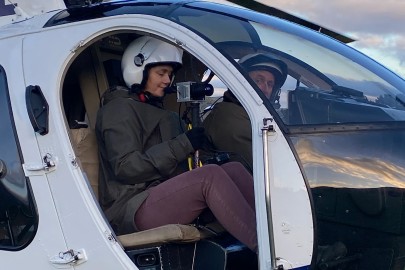Around the same time, a farmer introduced Bennett’s wallabies near Waimate in South Canterbury for recreational hunting. Wallabies from Kawau were later released in the Rotorua district. Now, more than 150 years on, New Zealand has a wallaby problem. They are a significant agricultural and conservation pest.
While the brush-tailed rock wallaby, and the swamp wallaby, are still contained on Kawau Island, the three wallaby populations on mainland AoNZ – Bennett’s wallaby in South Canterbury and dama and parma wallabies in the Rotorua lakes area – have slowly been spreading outside previously contained areas.
In 2015 the total gross economic impact of wallabies was estimated to be $28 million per annum, and if allowed to spread at their current rate this could grow to nearly $84 million per annum by 2025 and to increase each subsequent year..
In 2012 wallabies were declared an unwanted organism under the Biosecurity Act 1993, and an increasing focus has been put on work to keep wallabies in the containment areas designated in regional pest management plans. The current tranche of work is focused on eliminating outlier populations by 2025. This is an escalation of the management efforts regional councils lead.
Manaaki Whenua has been working closely with Biosecurity New Zealand (Ministry for Primary Industries) and other stakeholders as part of the Tipu Mātoro National Wallaby Eradication Programme ( Tipu Mātoro) to identify and prioritise research projects to achieve this goal. This includes work through a research partnership agreement with Biosecurity New Zealand.
There are more than 21 projects underway or recently completed at Manaaki Whenua that are focused on wallabies. These include tracking wallabies as they invade new areas, scent lures, monitoring and detection methods and human behavioural studies conducted through social science surveys of people’s motivations for transporting and releasing wallabies around the country – which is illegal under the Biosecurity Act.

Senior technician Sam Brown equipped with a thermal camera that is used to detect wallabies
Technology is playing a key role including satellite GPS tracking collars (see Where's Wallaby?), thermal cameras, and genomics (see It's in the genes) that are all part of a growing arsenal against the invasive marsupial.
The challenge to achieving local elimination is firstly to know where the wallabies are, which means there must be an effective way of detecting them, especially when they are in very low numbers. Manaaki Whenua programme lead and researcher Bruce Warburton says two key concepts are central to this research: detection probability and surveillance system sensitivity. “Detection probability refers to the likelihood of a method detecting an individual wallaby present at one of the specific locations surveyed. Surveillance sensitivity, on the other hand, is the probability that any of the survey methods employed will detect an individual across an entire area of interest,” he says.
Bruce and colleague Dr Dave Latham’s study evaluated several survey methods, including ground hunters with dogs, helicopter observers, thermal imaging cameras on helicopters, and camera traps. Researchers used detection probabilities obtained in conjunction with search efforts to estimate the surveillance sensitivity for each method, and, subsequently, to calculate the cost per hectare for surveillance.
Because estimating the number of wallabies in the wild is difficult, the researchers fitted GPS collars on captured wallabies, which recorded location data at high frequency (every 5 seconds) after the wallabies were released, providing a known number of wallabies for potential detection.
The results were mixed, says Bruce. “Ground hunters with dogs, and the trail cameras are most effective, although these are limited in scope when it comes to surveying large areas quickly,” he says. “Aerial methods, although less effective and more costly per hectare, allow for the rapid survey of extensive areas.”
He says there is a clear need for innovation and the development of new methods to detect animals at very low densities so they can be eliminated.
Current pest control relies heavily on the use of toxic baits. Manaaki Whenua researchers have been working on more subtle behavioural and motivational aspects of predator control and have been identifying and testing a range of novel, food-based, olfactory lures for their ability to attract target species to baits.
These scent lures include a synthetic green-leaf volatile, a colourless, oily liquid with an intense grassy odour of freshly cut green grass and leaves. It is produced in small amounts by most plants and acts as an attractant to many predatory insects. It is also an important aroma compound, often used in fruit and vegetable flavours and in perfumes.
Studying camera footage from the bait traps, researchers noticed a fascinating species interaction at play that could potentially undermine management efforts. A complex dynamic at bait feeders shows brushtail possums are behaviourally dominant over the larger wallabies. This dominance results in a reduced efficacy of bait feeders for wallaby control, because possums often consume or spoil the bait before wallabies can feed, and their presence can disrupt wallaby feeding, potentially leading to sub-lethal dosing and bait shyness in wallabies (see Back off, it's mine!).
As part of the Tipu Mātoro programme, Manaaki Whenua also surveyed and analysed data on people’s beliefs, attitudes, and motivations regarding the illegal catch and release of wallabies.
“We wanted to understand why people engage in this illegal behaviour and what might be done to prevent it,” says project lead Dr Geoff Kaine. “Our results are already being used in the Tipu Mātoro programme to develop the programmes regarding the timing, targeting, and content of awareness campaigns seeking to promote reporting by the public of sightings of wallabies and discourage catch-and-release.”
Data collected across these programmes can inform management strategies at the boundaries of wallaby distribution, including buffer zones. It can also guide operational planning by identifying dispersal routes, barriers, movement corridors, dispersal distances, and preferred habitats for settling. Understanding all these factors will go a long way towards helping solve the 150-year-old wallaby problem.
